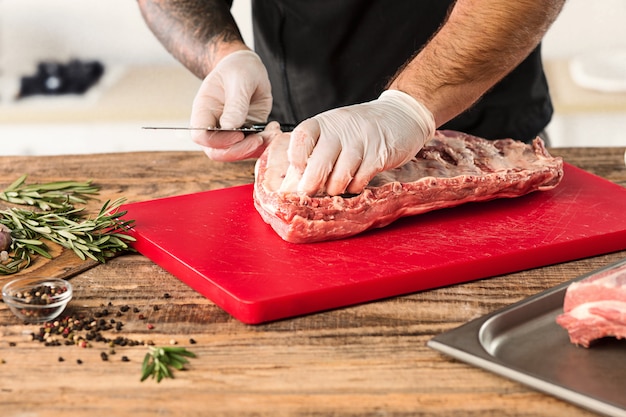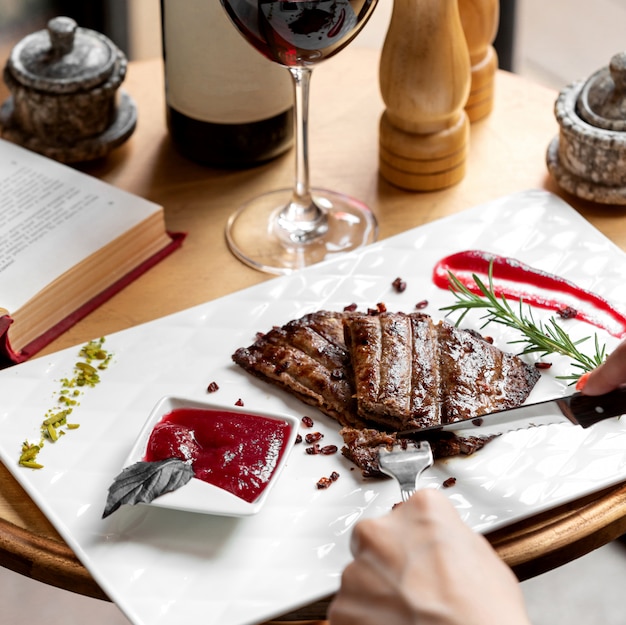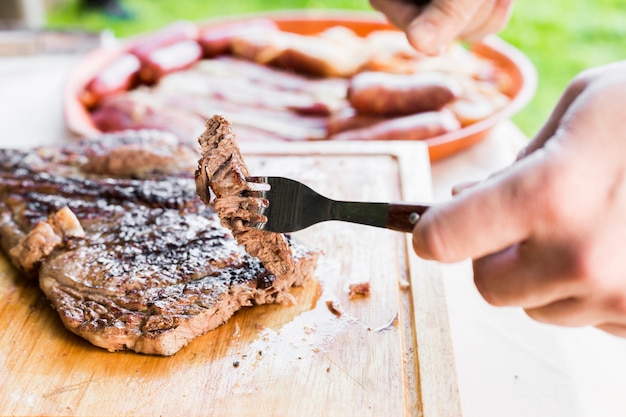Let's talk steak. A juicy, perfectly cooked steak is a culinary masterpiece, a symphony of flavour and texture that can make any meal feel special. But let's be honest, nailing a steak can feel like a bit of a gamble sometimes. You might have encountered the dreaded dry, overcooked slab, or perhaps a limp, undercooked disaster. I've definitely been there, a few times too many! But don't worry, after years of experimentation (and a few burnt offerings!), I've learned a thing or two about cooking steak like a pro. So, grab your apron, sharpen your knife, and let's dive into the world of steak perfection together. This is your ultimate guide to mastering the art of the perfect steak, from choosing the right cut to nailing the perfect sear.
(Part 1) choosing the right steak: The Foundation of Flavor

The first step to a stellar steak is selecting the right cut. It's like picking out the perfect piece of fabric for your masterpiece – you need the right foundation to build upon. While there's no shortage of cuts to choose from, some are better suited for different cooking methods. I'll break down a few popular choices and their best uses:
Understanding steak cuts: A Quick Guide
Let's get to grips with some of the most common steak cuts:
- Rib-Eye: This cut is known for its marbling, resulting in a juicy and flavorful steak. It's great for grilling, pan-searing, and roasting, and holds up well to higher temperatures. Think of it as the king of steaks, perfect for those who appreciate a rich, buttery flavour.
- new york strip: This cut is a classic for a reason. It has a good amount of marbling, resulting in a tender and flavorful steak. It's excellent for grilling, pan-searing, and broiling, and works well with bold spices. This is a good choice for those who like a firm texture and a touch of spice.
- Sirloin: A versatile cut that's leaner than rib-eye and New York Strip, making it a good choice for those who prefer a less fatty steak. It's great for grilling, pan-searing, and roasting. The sirloin is a solid choice if you’re looking for a more lean and flavourful steak.
- filet mignon: This tender and delicate cut is known for its buttery texture and rich flavor. It's best for cooking over low heat, like grilling or pan-searing. This is a luxurious choice for those who appreciate a melt-in-your-mouth experience.
- Tenderloin: A long and lean cut that's ideal for roasting or grilling whole. It's less marbled than other cuts, so it's important to cook it properly to avoid dryness. Consider this cut if you're looking for a substantial steak to share.
- flank steak: This cut is known for its bold flavor and chewy texture. It's best for grilling or marinating, and is often used in stir-fries and other Asian dishes. A flavorful and affordable option for those who like a bit of a chew.
- skirt steak: Another cut that's ideal for grilling or stir-fries, skirt steak is known for its rich flavor and tenderness when cooked correctly. It's a great option if you’re looking for a flavorful and affordable steak. The skirt steak is a versatile choice for those who enjoy bold flavours and a quick cook.
Matching Cuts to Cooking Methods
Here's how to pair up some common cooking methods with the right cuts:
- Grilling: Rib-eye, New York Strip, Sirloin, Flank Steak, Skirt Steak. Grilling is perfect for bringing out the smoky flavours of these cuts.
- Pan-searing: Rib-eye, New York Strip, Filet Mignon, Sirloin. Pan-searing is a great way to achieve a crispy crust and juicy interior for these cuts.
- Roasting: Rib-eye, Tenderloin, Sirloin. Roasting is a great way to cook a whole steak or tenderloin to a perfect level of doneness.
- Broiling: New York Strip, Sirloin. Broiling is a fast cooking method that's perfect for these thicker cuts.
(Part 2) The Art of Steak Preparation: From Butcher Block to Plate

You’ve got your cut, but before you start sizzling, there are a few preparation steps to ensure your steak is ready for its moment of culinary glory.
Temper Your Steak: The Key to Even Cooking
Remember those times when you've grilled a steak, and it seems to cook unevenly, with the outside burnt and the inside still raw? Tempering your steak, which means bringing it to room temperature before cooking, is the secret to even cooking. It allows the steak to heat up gradually, so it cooks more evenly and prevents the outside from burning before the inside is done. Imagine your steak as a marathon runner – you wouldn't expect them to run a race without warming up, right? The same principle applies to your steak.
Seasoning for Steak Perfection: Less is More
I’ve seen folks go crazy with the seasoning, but sometimes less is more. A simple sprinkle of salt and pepper, just before cooking, can actually do wonders. Let the natural flavors of the steak shine. But if you want to add a bit more flair, try some garlic powder, onion powder, or smoked paprika. I always keep a few gourmet salt and pepper blends on hand for a touch of luxury. Just remember, the star of the show is the steak, so keep the seasonings simple and let the meat sing!
(Part 3) Mastering the Art of Grilling: Steak Heaven on the Grill

Ah, the grill. The sizzle, the smell, the whole outdoor experience… there’s just something special about grilling a steak. I’ve spent countless evenings perfecting my grilling technique, and I'm here to share some essential tips.
Get Your Grill Ready: A Hot Start for a Great Steak
You’ll want your grill screaming hot, especially for those delicious grill marks. Preheat your gas grill to high heat, and for a charcoal grill, let the coals burn until they're white-hot with a layer of ash. You want those grates to be sizzling hot! Think of it like a hot pan – the hotter it is, the better the sear on your steak.
Grilling Time: Sealing in the Flavor
Place your seasoned steak on the grill, and don’t overwork it. Just a few minutes per side to get that beautiful sear and lock in the juices. You want to hear that satisfying sizzle and see those grill marks forming.
The Flip: A Crucial Moment
When it’s time to flip, be patient! The steak should have those nice grill marks and release easily from the grill. Flip it once, and then continue cooking. You'll know it's ready to flip when it offers some resistance when you gently try to move it.
Check for Doneness: The Ultimate Test
To ensure your steak is cooked to perfection, use a meat thermometer. For a rare steak, aim for 125°F (52°C); medium-rare, 135°F (57°C); medium, 145°F (63°C); medium-well, 155°F (68°C); and well-done, 160°F (71°C). This is the most reliable way to ensure your steak is cooked to your liking.
Rest Time: Letting the Steak Relax
After grilling, let your steak rest for 5-10 minutes before slicing. This allows the juices to redistribute, resulting in a tender and juicy steak. Cover it loosely with foil to keep it warm and prevent it from drying out. Think of it like giving your steak a little spa treatment after its grilling session.
(Part 4) Pan-Searing: The Perfect Steak on the Stovetop
You don’t need a fancy grill to cook a great steak. A hot pan can be just as effective! Here’s my approach to pan-searing a steak like a pro.
The Pan: Choosing the Right Tool
cast iron skillets are perfect for pan-searing steak, they retain heat extremely well, leading to a beautiful sear. If you don't have a cast iron skillet, a heavy-bottomed stainless steel pan will work just as well. Cast iron is a classic for a reason – it heats up evenly and retains heat well, which is crucial for achieving that perfect sear.
Heating the Pan: Ready for Action
Get that pan screaming hot. Add a tablespoon or two of oil, and let it heat up over medium-high heat. You want the oil to be shimmering before you add the steak. The oil should be hot enough to sizzle when you add the steak.
Searing the Steak: A Beautiful Crust
Carefully place your seasoned steak in the hot pan. Don't overcrowd the pan. Let the steak cook undisturbed for 2-3 minutes per side, until it develops a beautiful brown crust. The key here is patience – let the steak sear undisturbed for a crispy, flavorful crust.
Turning the Steak: Time to Flip
When the steak is nicely seared, flip it over and continue cooking for another 2-3 minutes per side. You can adjust the cooking time depending on your desired level of doneness. When you're ready to flip, you should see a nice, crispy crust on the bottom of the steak.
Temperature Check: No Guesswork
Use a meat thermometer to check the internal temperature of the steak. Remember, rare is around 125°F (52°C), medium-rare is around 135°F (57°C), medium is around 145°F (63°C), medium-well is around 155°F (68°C), and well-done is around 160°F (71°C). A meat thermometer is your best friend when it comes to steak. It eliminates the guesswork and ensures your steak is cooked to your liking.
Resting Time: A Final Touch
Transfer the steak to a cutting board and let it rest for 5-10 minutes before slicing. This allows the juices to redistribute, making for a tender and juicy steak. Think of the resting time as a final act of kindness to your steak, allowing it to relax and release its delicious juices.
(Part 5) Beyond the Basics: Adding Flavors and Techniques
Now, let's take your steak skills to the next level! It's time to dive into some fun techniques and flavour additions that will make your steak truly stand out.
Marinade Magic: Adding Depth of Flavor
Marinades can infuse your steak with flavour and tenderness. Experiment with different combinations of herbs, spices, citrus juices, and even wine. Just make sure to marinate the steak for at least 2 hours, or ideally overnight, to allow the flavours to penetrate. Think of a marinade as a flavour bath for your steak, adding depth and complexity.
The reverse sear: Tenderness and Flavor
This technique involves slow cooking the steak in a low oven before searing it on high heat. It results in an incredibly tender steak with a flavorful crust. For this technique, preheat your oven to 275°F (135°C), place the steak in a baking dish, and cook for about 30 minutes per inch of thickness. Then, transfer the steak to a hot skillet or grill and sear it for about 2 minutes per side. The reverse sear is a great way to achieve a perfectly tender interior and a beautiful crust.
Steak Rubs: Tailored flavor profiles
Steak rubs are a mixture of herbs and spices that create a flavorful crust on your steak. You can find pre-made rubs, or get creative and make your own. Common ingredients include smoked paprika, garlic powder, onion powder, cumin, coriander, oregano, thyme, and cayenne pepper. Steak rubs are like the finishing touch on a masterpiece, adding a burst of flavor and aroma.
Sous Vide: Precise Temperature Control
sous vide cooking involves immersing your steak in a water bath set to the desired internal temperature. This method ensures a perfectly even cook, resulting in a tender and juicy steak. It's a great option for those who want consistent results and prefer a more hands-off approach. Sous vide is a great option for those who want to achieve precise cooking and consistent results.
(Part 6) Mastering the Sides: Complementary Flavor Partners
A great steak deserves great company! Here are some side dish ideas that will perfectly complement your culinary masterpiece.
The Classics: Tried and True
- mashed potatoes: Creamy, comforting, and a classic pairing for steak. The perfect creamy and comforting sidekick for a juicy steak.
- Roasted Vegetables: Asparagus, broccoli, Brussels sprouts, or carrots roasted to perfection. A healthy and vibrant addition to any steak dinner.
- Garlic Bread: A simple yet delicious addition to any steak dinner. A classic combination that's always a crowd-pleaser.
- Mac and Cheese: A cheesy and comforting side that will make any steak meal feel special. A decadent and satisfying companion for a hearty steak.
Going Beyond: Exploring New flavor combinations
- grilled corn on the Cob: A fresh and seasonal side that complements the smoky flavors of grilled steak. A sweet and smoky counterpoint to the savory flavours of steak.
- potato salad: A creamy and tangy side that adds a touch of sophistication to your steak meal. A classic side dish with a touch of elegance.
- Grilled Mushrooms: A hearty and flavorful side that pairs well with steak. A savory and earthy accompaniment to your steak.
- Tomato and Cucumber Salad: A refreshing and light side that balances the richness of steak. A light and refreshing contrast to the richness of steak.
(Part 7) steak sauces: Elevating Your Culinary Game
A drizzle of sauce can transform your steak from good to amazing! Let's explore a few delicious options.
Classic Steak Sauce: A Timeless Favorite
A simple combination of Worcestershire sauce, tomato paste, garlic powder, onion powder, and black pepper. This sauce is versatile and complements most cuts of steak. The classic steak sauce is a tried-and-true choice that enhances the flavour of any steak.
Creamy Mushroom Sauce: Rich and Savory
A decadent sauce made with cream, mushrooms, and a touch of garlic. It's a perfect pairing for grilled or pan-seared steak. This sauce adds a rich and earthy dimension to your steak.
Béarnaise Sauce: A French Classic
A classic French sauce made with egg yolks, butter, tarragon, and white wine vinegar. It's a rich and flavorful sauce that pairs well with grilled steak. This sauce is a sophisticated and elegant option for your steak.
Red Wine Reduction: Sophisticated and Flavorful
Made by simmering red wine with shallots, garlic, and herbs until it reduces to a thick and flavorful sauce. It's a sophisticated and delicious option for steak. This sauce adds a depth of flavour and a touch of elegance to your steak.
Peppercorn Sauce: A Touch of Spice
A peppery sauce made with black peppercorns, butter, and cream. It's a great option for adding a touch of spice to your steak. This sauce is perfect for those who enjoy a bit of heat.
(Part 8) FAQs: steak cooking Questions Answered
Got some burning questions about steak? I've compiled a list of common questions and their answers.
FAQs
| Question | Answer |
|---|---|
| How do I tell if a steak is cooked to my liking? | The best way to determine the doneness of a steak is to use a meat thermometer. You can also use the touch method, but it’s not as precise. Rare: 125°F (52°C), Medium-rare: 135°F (57°C), Medium: 145°F (63°C), Medium-well: 155°F (68°C), Well-done: 160°F (71°C). Doneness is a matter of personal preference, but a meat thermometer ensures that your steak is cooked to your liking. |
| What’s the best way to store steak? | Store steak in the refrigerator for up to 5 days. Wrap it tightly in plastic wrap or place it in an airtight container. For longer storage, freeze the steak for up to 6 months. Proper storage is key to maintaining the quality and freshness of your steak. |
| How long should I grill or pan-sear a steak? | The grilling or pan-searing time will vary depending on the thickness of the steak and your desired level of doneness. As a general rule, grill or pan-sear for 2-3 minutes per side for a medium-rare steak. The thickness of the steak and your desired doneness will determine the cooking time. |
| What are some good marinades for steak? | There are countless marinade options, but some popular choices include:
|
| What’s the difference between grilling and pan-searing? | Grilling involves cooking over direct heat, often from charcoal or gas. Pan-searing involves cooking over high heat in a skillet. Both methods produce a delicious sear on the steak, but grilling often adds a smoky flavor. While both methods create a delicious sear, grilling often adds a smoky flavour that's not present in pan-searing. |
(Part 9) Conclusion: Embracing the Steak Journey
So, there you have it! You've now got the knowledge and skills to become a steak-cooking maestro. Remember, there’s no shortcut to perfecting the art of steak cooking. It’s a journey of experimentation, observation, and a dash of patience. Don’t be afraid to try new techniques, explore different flavours, and discover what works best for you. So, next time you're craving a perfect steak, you'll be ready to unleash your inner grill master. Happy cooking, and may your steak be always perfectly cooked!
Everyone is watching

How to Cook Frozen Lobster Tails Perfectly: A Step-by-Step Guide
RecipesLobster. Just the word conjures up images of lavish meals, special occasions, and a taste of luxury. But let's...

Pigs in a Blanket Cooking Time: How Long to Bake for Perfect Results
RecipesAh, pigs in a blanket. Just the name conjures up images of those delightful little parcels of crispy pastry en...

Pork Fillet Cooking Time: How Long to Cook It Perfectly
RecipesPork fillet, or tenderloin as it's sometimes called, is a real favourite in our house. It's so versatile, and...

The Ultimate Guide to Cooking Delicious Frankfurters
RecipesLet's face it, we all love a good frankfurter. It's a classic, simple, and always satisfying. But let's be rea...

Wolf Meat Recipes: A Guide to Cooking Wild Game
RecipesLet's be honest, you don't see wolf meat at your local butcher shop every day. It's a bit of a wild card, but ...
